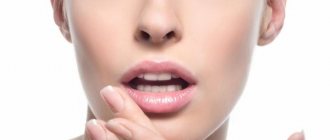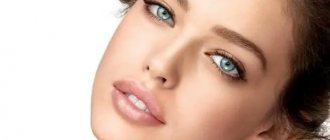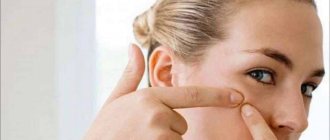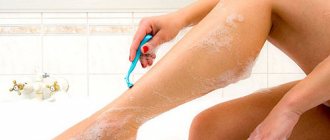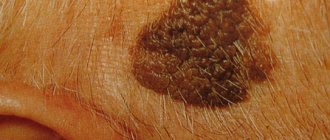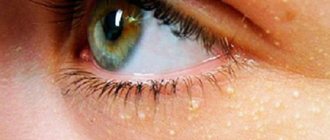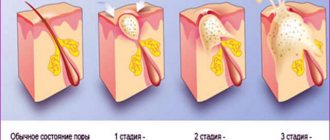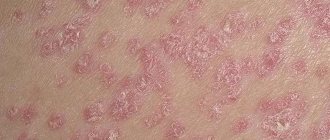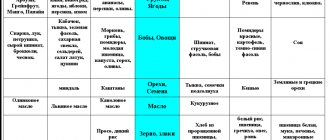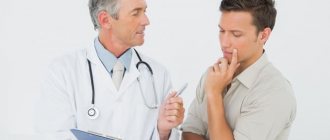Peering into the faces of your favorite movie characters, admiring the flawless skin of TV presenters and celebrities from magazine covers, who doesn’t dream of the same perfect skin? But my own reflection in the mirror makes me sad. Numerous white pimples on the face, inside the lips or nose are not only not aesthetically pleasing, but are often a sign of impaired metabolism, and we wonder how to treat white pimples on the face.
Causes of acne formation
The causes of acne can be roughly classified as follows:
External reasons (related to adverse environmental influences):
- High dust and gas content in the air.
- Bacteria and viruses.
- Changes in ambient temperature.
- Cosmetic preparations (fat creams, powder, etc.).
- Mechanical impact (friction against rough fabric of clothing).
- Failure to comply with hygiene rules.
Internal reasons (due to changes in the functioning of internal organs):
Did you know that the location of white pimples indicates diseases of the internal organs?
- Hormonal imbalance. Most often we are talking about increased activity of male sex hormones, but the cause of acne can also be a violation of carbohydrate metabolism in diabetes mellitus or increased production of glucocorticoids.
- Stress and psycho-emotional tension.
- Diseases of the digestive system: dysbiosis, liver dysfunction, gastritis and inflammatory bowel diseases.
- Kidney diseases.
- Weakening of the immune system.
- Lack of vitamins.
- Genetic predisposition.
External and internal causes cause dysfunction of the sebaceous glands, which are sacs filled with a mixture of fats. Through special ducts, the secretion of the glands (sebum) is released out and forms the hydrolipid mantle of the skin. The latter prevents the penetration of harmful substances and bacteria into the layers of the skin, maintains its elasticity and protects it from the adverse effects of the environment. When the composition and consistency of the secretion changes or due to the closure of the ducts, the sacs of the sebaceous glands do not empty and inflammation develops.
Cosmetology procedures
Peeling
Peeling – helps renew the outer layer of skin, cleansing pores of excess sebum and dirt.
The procedure is quite harsh - the epidermis is literally “burned” with chemicals (concentrated acids).
Peeling is not a method of treating subcutaneous acne, but of polishing the skin, smoothing out scars, red spots and unevenness after complete removal of boils.
Dermabrasion
Dermabrasion is a procedure similar in effectiveness to peeling, but is performed not chemically, but mechanically: a stream of aluminum salts is used, aimed at the affected areas.
Laser resurfacing
Laser resurfacing – laser removal of the top layer of skin.
As a result, a significant flow of oxygen to renewed cells is accelerated, external defects are eliminated, even shallow wrinkles are removed, and the complexion becomes healthy.
This method is regenerative, old cells are removed and new and healthy cells begin to grow, additional portions of collagen are produced.
Development and symptoms of inflammation
The manifestations of acne depend on the depth of damage to the skin layers and the presence of infection. It is customary to distinguish three stages in the formation of a pimple.
Stages of development
- The initial stage is marked by the appearance of small white pimples inside the skin. These formations, comedones, are small non-inflammatory cysts. They are formed as a result of the accumulation of detritus (fats and dead cells) in the sebaceous glands.
- If an infection occurs, inflammation develops and the process enters the second stage. A compaction forms around the central whitish point, the skin acquires a reddish-bluish tint, and a painful sensation appears when pressed. Once formed, a pimple can open spontaneously or continue to develop.
- At the third stage, suppuration develops with the formation of a painful vesicle of soft consistency. Scars often remain at the site of opening of large, more than 5 mm, pustules.
General principles of therapy
The modern pharmaceutical market offers many treatments for acne. However, it is worth choosing a drug wisely. First of all, it is advisable to consult with a specialist and, if necessary, undergo examinations for diseases of the internal organs, as a possible cause of acne. If the skin lesion is caused by external influences, then, under the guidance of a dermatovenerologist or cosmetologist, select a drug in accordance with the stage of development of the pimple and the severity of the lesion.
A mild degree of damage includes the use of such cleansing gels as “Clerasil Ultra”, “Exfoliak” and many other modern drugs. For stages 2 and 3 of the disease, the use of a number of modern medications is effective.
Retinoids (structural analogues of vitamin A).
Drugs of this group penetrate into the nucleus, where they bind to DNA and inhibit the division of skin cells. Retinoids improve the evacuation of detritus from the sebaceous glands, reduce the formation of sebum, and have an anti-inflammatory and antimicrobial effect. The advantage of retinoids is their natural origin, which significantly reduces the risk of adverse reactions. Various drugs from this group are used for topical use.
Retinoic ointment 0.05 and 0.1% is applied 2 times a day to the affected areas, avoiding contact of the medicine with the skin around the eyes and nasolabial triangle. The drug is used for one to three months. If a repeated course of treatment is necessary, you should consult your doctor.
"Lokacid" is available in the form of a cream, which allows the active principle to penetrate into the deeper layers of the dermis, providing the drug with a higher effect. The drug is able to dissolve comedones, improving the release of the contents of the sebaceous glands to the outside. An additional advantage of Lokacid is its ability to stimulate the synthesis of elastic fibers in the dermis, which promotes the healing of opened pimples without scars. The drug stimulates local immunity and increases the resistance of the skin to the introduction of microbes. An analogue of Lokacid is Retin-A®. Among modern agents, the retinoid metabolite Differin deserves attention.
Antibacterial agents
Medicines that have a detrimental effect on pathogenic microbes are usually divided into antibiotics and substances of synthetic origin. Each subgroup has its own advantages and disadvantages.
Antibiotics
Erythromycin and clindamycin are the most widely used drugs for the treatment of acne. Both substances disrupt protein synthesis in the bacterial cell and inhibit its reproduction. These antibiotics are active against a wide range of microorganisms.
Erythromycin ointment (10,000 units/g) has less effect. Probably, the high activity of the second antibiotic in acne is mediated by deeper disturbances in the protein synthesis of bacteria and its ability to reduce the concentration of free fatty acids on the skin. Clindamycin is available in the form of Dalatsin® and Clindovit® gels, and Zerkalin solution for external use.
Despite the local use of these drugs, it should be borne in mind that their long-term use can lead to the penetration of the antibiotic into the general bloodstream and cause undesirable reactions. From these positions, the less toxic erythromycin wins. However, clindamycin has higher antimicrobial activity. The risk of developing allergic reactions is also more often observed during treatment with clindamycin. In addition, with prolonged use of antibiotics, bacteria may lose sensitivity to them. At the same time, to achieve a therapeutic effect, a course of treatment is recommended. To avoid mistakes when deciding to use these drugs, you should always consult your doctor for advice.
Synthetic antimicrobial agents used for skin inflammatory diseases are represented by benzoyl peroxide, azelaic acid and zinc hyaluronidase. Benzoyl peroxide is available in the form of a gel for external use and is known under the trademarks “Baziron AS”, “Eclaran 5”, “Deskvam” and some others. The drug reduces the formation of detritus in the sebaceous glands and the formation of comedones. Azelaic acid preparations, Azelik®, Skinoklir and others, have a local irritant effect, which is manifested by itching, burning and redness. The advantage of zinc hyaluronidase is the acceleration
Combined drugs. Among this group of drugs, interest in balsamic liniment according to Vishnevsky has not disappeared to this day. Birch tar, castor oil and xeroform in the composition of the drug provide antimicrobial and anti-inflammatory effects. More modern combination products are “Duak-gel” (clindamycin + benzoyl peroxide), “Deriva-S” (clindamycin + adapalene retinoid), “Isotrexin gel” (erythromycin + isotretinoin retinoid). The list goes on, but the main idea of such combinations is that the second component increases the activity of the antibiotic.
Home remedies for getting rid of subcutaneous acne on the face
Salt
The simplest option that can help in the described situation at home. You can use both table and sea salt.
Salt will relieve inflammation, disinfect the affected area of the face, and enrich the skin with vitamins and beneficial microelements.
To prepare a compress, you need to dissolve two large spoons of salt in 0.2 liters of hot water. The solution is brought to a boil, then gauze is soaked in it and applied to the skin in the affected area. You can do up to four procedures per day.
Vishnevsky ointment"
This ointment is sold in pharmacies, but it costs a penny and turns out to be effective. You will need to make a compress and leave it for 12 hours. As a result, the inflammation will go away immediately; swelling and redness of the facial skin will also decrease.
Fresh lemon juice
Take a lemon, from which you need to squeeze the juice. Then dilute the juice in equal proportions with clean water. The product is suitable not only for eliminating existing subcutaneous acne, but also for preventing such formations.
This is due to the fact that this composition provides the skin with an acidic environment. This environment kills pathogenic microflora. Plus, lemon can whiten the skin and promote vasoconstriction.
Aloe-based compresses
A simple and effective option on how to get rid of subcutaneous acne on the face at home. You will need to pick an aloe leaf and cut it lengthwise.
Then apply to the pimple and fix, leave for 10 hours. After three such compresses, acne should go away.
Nettle leaf decoction
A decoction of nettle leaves will need to be drunk in a glass for 30 days. This folk remedy helps normalize metabolism and removes waste and toxins from the body. As a result, the amount of rash on the face is significantly reduced.
Tea tree oil
It is used for deep cleansing, which is extremely important when a subcutaneous pimple appears. You can wipe the affected areas with this oil every few hours. Tea tree oil will help get rid of inflammation and reduce the size of the rash.
Why shouldn't you treat acne yourself?
No source of information will ever give you the knowledge that a specialist has, and, therefore, the risk of complications and adverse reactions from incorrect selection of a drug becomes too great. What if you make your inflammatory skin lesions worse with the wrong combination of products? What if an allergic reaction develops? The list of “ifs” can be continued. The main thing is to understand that successful acne treatment is impossible without the sensitive guidance of a good specialist.
